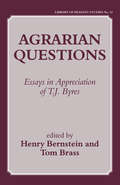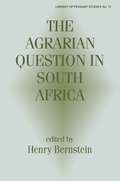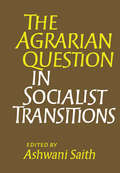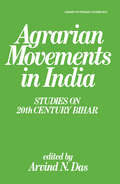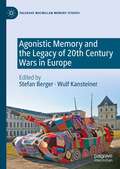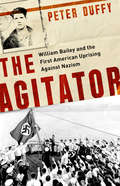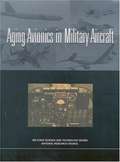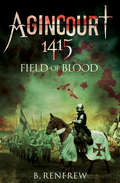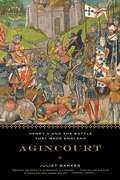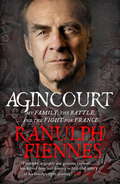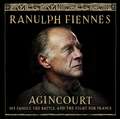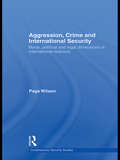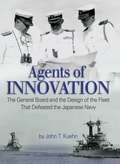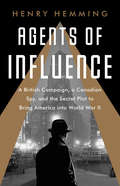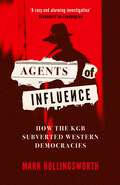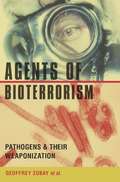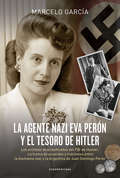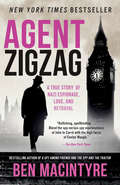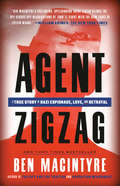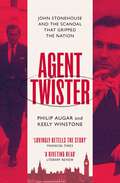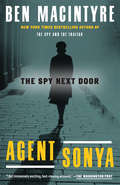- Table View
- List View
Agrarian Questions: Essays in Appreciation of T. J. Byres
by Henry Bernstein Tom BrassThis collection celebrates T.J. Byres' seminal contributions to the political economy of the agrarian question. Uniting the various themes is the demonstration of the continuing relevance of a critical, historical and comparative materialist analysis of agrarian question.
The Agrarian Question in South Africa
by Henry BernsteinThis is the first collection of its kind. It presents a critical political economy of the agrarian question in post-apartheid South Africa, informed by the results of research undertaken since the transition from apartheid started in 1990. The articles, by well-known South African, British and American scholars, cover a variety of topical theoretical, empirical and policy issues, firmly rooted in an historical perspective.
The Agrarian Question in Socialist Transitions
by Ashwani SaithFirst published in 1986. Routledge is an imprint of Taylor & Francis, an informa company.
Agrarian Movements in India: Studies on 20th Century Bihar
by Arvind N. DasFirst published in 1982. Routledge is an imprint of Taylor & Francis, an informa company.
Agonistic Memory and the Legacy of 20th Century Wars in Europe (Palgrave Macmillan Memory Studies)
by Stefan Berger Wulf KansteinerThis book discusses the merits of the theory of agonistic memory in relation to the memory of war. After explaining the theory in detail it provides two case studies, one on war museums in contemporary Europe and one on mass graves exhumations, which both focus on analyzing to what extent these memory sites produce different regimes of memory. Furthermore, the book provides insights into the making of an agonistic exhibition at the Ruhr Museum in Essen, Germany. It also analyses audience reaction to a theatre play scripted and performed by the Spanish theatre company Micomicion that was supposed to put agonism on stage. There is also an analysis of a Massive Open Online Course (MOOC) designed and delivered on the theory of agonistic memory and its impact on the memory of war. Finally, the book provides a personal review of the history, problems and accomplishments of the theory of agonistic memory by the two editors of the volume.
The Agitator: William Bailey and the First American Uprising against Nazism
by Peter DuffyThis story of an anti-fascist's dramatic and remarkable victory against Nazism in 1935 is an inspiration to anyone compelled to resist when signs of oppression are on the horizonBy 1935, Hitler had suppressed all internal opposition and established himself as Germany's unchallenged dictator. Yet many Americans remained largely indifferent as he turned his dangerous ambitions abroad. Not William Bailey.Just days after violent anti-Semitic riots had broken out in Berlin, the SS Bremen, the flagship of Hitler's commercial armada, was welcomed into New York Harbor. Bailey led a small group that slipped past security and cut down the Nazi flag from the boat in the middle of a lavish party. A brawl ensued, followed by a media circus and a trial, in which Bailey and his team were stunningly acquitted. The political victory ultimately exposed Hitler's narcissism and violent aggression for all of America to see.The Agitator is the captivating story of Bailey's courage and vision in the Bremen incident, the pinnacle of a life spent battling against fascism. Bailey's story is full of drama and heart--and it's an inspiration to anyone who seeks to resist tyranny.
Aging Avionics in Military Aircraft
by Air Force Science Technology Board National Research CouncilA summary of Aging Avionics in Military Aircraft
Agincourt, 1415: Field of Blood
by B. RenfrewA gripping fictionalized account of the landmark battle that turned the tide of history. On October 25, 1415, a trapped and vastly outnumbered force of exhausted and demoralized English archers and men-at-arms faced a colossal army of French knights on a desolate field in northern France. What took place that day became one of the greatest moments of the Hundred Years&’ War and English history. Based on chronicles of the times, Agincourt 1415: Field of Blood is a dramatic, minute-by-minute retelling of the battle as seen through the eyes of the commanders and soldiers on both sides. This is a brutal, bloody, and captivating retelling of a major British victory written by a Pulitzer Prize finalist. This work sets a new standard for historical fiction. &“If you look for a book to read on a chair next to the fireplace holding a glass of whiskey, this book is highly recommendable.&” —Historic Battlefield Tours
Agincourt: Henry V and the Battle That Made England
by Juliet BarkerWaged almost six centuries ago, the Battle of Agincourt still captivates. It is the classic underdog story, and generations have wondered how the English--outmanned by the French six to one--could have succeeded so bravely and brilliantly. Drawing on a wide range of sources, Juliet Barker paints a gripping narrative of the October 1415 clash between the outnumbered English archers and the heavily armored French knights. Populated with chivalrous heroes, dastardly spies, and a ferocious and bold king, AGINCOURT is as earthshaking as its subject--and confirms Juliet Barker's status as both a historian and a storyteller of the first rank.
Agincourt: My Family, the Battle and the Fight for France
by Ranulph Fiennes25 October 2015 was the 600th anniversary of the battle of Agincourt - a hugely resonant event in English (and French) history. Sir Ranulph Fiennes casts new light on this epic event, revealing that three of his own ancestors fought in the battle for Henry V, and at least one for the French. This is a unique perspective on Agincourt from a trained and decorated soldier. Ran reveals the truth behind the myths and legends of the battle. He tells how after the battle Henry V entertained his senior commanders to dinner, where they were waited on by captured French knights. There is the story of Sir Piers Legge of Lyme Hall, who lay wounded in the mud while his mastiff dog fought off the French men-at-arms. Then there is the legend that the French intended to cut off the first and second right hand fingers of every captured archer, to prevent him from using his bow. The archers raised those two fingers to the advancing French as a gesture of defiance. In this gripping study Sir Ranulph Fiennes brings back to life these stories and more, including those of his own ancestors, in a celebration of a historical event integral to English identity.Fiennes, arguably our greatest explorer...has delved deep into history to tell the story of his family's epic journey. - The Times
Agincourt: My Family, the Battle and the Fight for France
by Ranulph Fiennes25 October 2015 was the 600th anniversary of the battle of Agincourt - a hugely resonant event in English (and French) history. Sir Ranulph Fiennes casts new light on this epic event, revealing that three of his own ancestors fought in the battle for Henry V, and at least one for the French. This is a unique perspective on Agincourt from a trained and decorated soldier. Ran reveals the truth behind the myths and legends of the battle. He tells how after the battle Henry V entertained his senior commanders to dinner, where they were waited on by captured French knights. There is the story of Sir Piers Legge of Lyme Hall, who lay wounded in the mud while his mastiff dog fought off the French men-at-arms. Then there is the legend that the French intended to cut off the first and second right hand fingers of every captured archer, to prevent him from using his bow. The archers raised those two fingers to the advancing French as a gesture of defiance. In this gripping study Sir Ranulph Fiennes brings back to life these stories and more, including those of his own ancestors, in a celebration of a historical event integral to English identity.Fiennes, arguably our greatest explorer...has delved deep into history to tell the story of his family's epic journey. - The Times
Agincourt: My Family, the Battle and the Fight for France
by Ranulph Fiennes25 October 2015 is the 600th anniversary of the battle of Agincourt - a hugely resonant event in English (and French) history. Sir Ranulph Fiennes casts new light on this epic event, revealing that three of his own ancestors fought in the battle for Henry V, and at least one for the French. This is a unique perspective on Agincourt from a trained and decorated soldier. Ran reveals the truth behind the myths and legends of the battle. He tells how after the battle Henry V entertained his senior commanders to dinner, where they were waited on by captured French knights. There is the story of Sir Piers Legge of Lyme Hall, who lay wounded in the mud while his mastiff dog fought off the French men-at-arms. Then there is the legend that the French intended to cut off the first and second right hand fingers of every captured archer, to prevent him from using his bow. The archers raised those two fingers to the advancing French as a gesture of defiance. In this gripping new study Sir Ranulph Fiennes brings back to life these stories and more, including those of his own ancestors, in a celebration of a historical event integral to English identity.(P)2014 Hodder & Stoughton
Aggression, Crime and International Security: Moral, Political and Legal Dimensions of International Relations (Contemporary Security Studies)
by Page WilsonAggression, Crime and International Security examines the concept of aggression in international relations and how it has been dealt with by international law and collective security organisations. This book analyses the evolution of the concept of aggression in international relations from World War I to the post-Rome Statute era. It charts the emergence of two competing visions of this notion: on the one hand, as a triggering mechanism for collective security enforcement among states, and, on the other, as an international crime giving rise to individual responsibility. The author argues that despite certain contemporary international trends suggesting a shift away from traditional, state-centric power structures towards a more cosmopolitan, globalized polity, the history of the concept of aggression demonstrates just how far away this is in reality. By examining aggression in theory and practice at the League of Nations, the Nuremberg and Tokyo Trials, the United Nations, the conference establishing the Rome Statute, and beyond, the book reveals the recurring moral, political and legal challenges this concept poses - challenges which continue to be at the forefront of thinking about international relations today. This book will be of great interest to students of International Law, War Crimes, International Relations and Security Studies.
The Agent's Surrender
by Kimberly Van MeterRival agents uncover a monstrous conspiracy From the moment they met, sparks had flown...and not the good kind. Agent Jane Fallon would rather chew nails than work with arrogant-and much too good-looking-Holden Archangelo. But, convinced his brother was no traitor, Holden had Jane's investigation reopened. And now Jane is forced to partner with him. As new leads come to light, Jane's certainty about the case is shaken. But the assassin's bullet whizzing past her head convinces her they are onto something. Jane's determined to keep things professional, but as the danger around them intensifies, so does the fierce attraction they try so hard to deny....
Agents of Innovation
by John T. KuehnThe author examines the influence of the General Board of the U.S. Navy as an agent of innovation in the years between the world wars. A formal body established by the secretary of the Navy, the General Board served as the organizational nexus for the interaction between fleet design and the naval limitations imposed on the Navy by treaty. Particularly important, Kuehn argues, was the Board's role in implementing the Washington Naval Treaty, which limited naval armaments after 1922. Kuehn explains that the leadership of the Navy at large and the General Board in particular felt themselves especially constrained by Article XIX of the Washington Naval Treaty, which implemented a status quo on naval fortifications in the western Pacific.
Agents of Influence: A British Campaign, a Canadian Spy, and the Secret Plot to Bring America into World War II
by Henry HemmingThe astonishing story of the British spies who set out to draw America into World War IIAs World War II raged into its second year, Britain sought a powerful ally to join its cause-but the American public was sharply divided on the subject. Canadian-born MI6 officer William Stephenson, with his knowledge and influence in North America, was chosen to change their minds by any means necessary.In this extraordinary tale of foreign influence on American shores, Henry Hemming shows how Stephenson came to New York--hiring Canadian staffers to keep his operations secret--and flooded the American market with propaganda supporting Franklin Roosevelt and decrying Nazism. His chief opponent was Charles Lindbergh, an insurgent populist who campaigned under the slogan "America First" and had no interest in the war. This set up a shadow duel between Lindbergh and Stephenson, each trying to turn public opinion his way, with the lives of millions potentially on the line.
Agents of Influence: How the KGB Subverted Western Democracies
by Mark HollingsworthThere&’s no such thing as a former KGB man. Agents of Influence reveals the secret history of an intelligence agency gone out of control, accountable to no one but itself and intent on subverting Western politics on a near-inconceivable scale. In 1985, 1,300 KGB officers were stationed in the USA. The FBI only had 350 counter-intelligence officers. Since the early days of the Cold War, the KGB seduced parliamentarians and diplomats, infiltrated the highest echelons of the Civil Service, and planted fake news in papers across the world. More disturbingly, it never stopped. Putin is a KGB man through and through. Journalist Mark Hollingworth reveals how disinformation, kompromat and secret surveillance continue to play key roles in Russia&’s war with Ukraine. It seems frighteningly easy to destabilise Western democracy.
Agents of Influence (Star Trek: The Original Series)
by Dayton WardAn epic new Star Trek saga by New York Times bestselling author Dayton Ward set during the original Five-Year Mission!For years, Starfleet Intelligence agents have carried out undercover assignments deep within the Klingon Empire. Surgically altered and rigorously trained in Klingon culture, they operate in plain sight and without any direct support, while collecting information and infiltrating the highest levels of imperial power. Their actions have given Starfleet valuable insight into the inner workings of Klingon government and its relentless military apparatus.After three of Starfleet&’s longest serving agents fear exposure, they initiate emergency extraction procedures. Their planned rendezvous with the USS Endeavour goes awry, threatening to reveal their activities and the damaging intelligence they&’ve collected during their mission. Tasked by Starfleet to salvage the botched rescue attempt, Captain James T. Kirk and the crew of the USS Enterprise must discover the truth behind a secret weapons experiment while avoiding an interstellar incident with the potential to ignite a new war between the Federation and one of its oldest adversaries.
Agents of Bioterrorism: Pathogens and Their Weaponization
by Geoffrey ZubayThis new work offers a clear and thorough account of the threats posed by bioterrorism from the perspective of biologists. The authors examine thirteen disease-causing agents, including those responsible for anthrax, the plague, smallpox, influenza, and SARS. Each chapter considers a particular pathogen from the standpoint of its history, molecular biology, pathology, clinical presentation, diagnosis, weaponization, and defenses. The book also examines strategies for making vaccines and protecting the population in a bioterror attack.
La agente nazi Eva Perón y el tesoro de Hitler: Los archivos desclasificados del FBI de Hoover. La trama de acuerdos y traiciones entre la Alemania nazi y la Argentina de Juan Domingo Perón
by Marcelo Damian GarcíaUn recorrido por las relaciones entre Juan Domingo Perón, Eva Duarte y el nazismo alemán tras la derrota, avalado por las investigaciones que mandó a realizar Hoover al frente del FBI. Con la debacle nazi consumada, el tablero de la política internacional comienza a reacomodarse. Mientras Adolf Hitler, en el exilio, pierde fuerza e influencia, Juan Domingo Perón -alentado por las circunstancias- se propone erigir a la Argentina como una nación rectora de Sudamérica, tomando la posta de la derrotada Alemania e intentando replicar su ímpetu expansionista en la región. ¿Cómo pretende Perón financiar sus planes de dominación? Mediante el expolio de las millonarias fortunas que fueron secuestradas por el nacionalsocialismo alemán y pacientemente trasladadas hasta Buenos Aires. Su mayor obstáculo será nadie menos que su propia esposa, Eva Duarte, quien pondrá en acción sus poderosas conexiones para salvaguardar esos tesoros. La agente nazi Eva Perón y el tesoro de Hitler nace del trabajo de investigación y consulta de cientos de documentos desclasificados -entre ellos, los de las pesquisas que mandó a hacer John Edgar Hoover cuando se encontraba al frente del FBI-, sobre los cuales el historiador Marcelo García construye una irresistible tesis destinada a entrelazar la inesperada y atrapante trama internacional de acuerdos y traiciones entre la Alemania nazi y la Argentina de Perón. El resultado de este enorme trabajo es un libro que revisa uno de los misterios más magnéticos del peronismo desde una perspectiva nueva: la de los conflictos de intereses entre sus dos más grandes figuras.
Agent Zigzag: A True Story of Nazi Espionage, Love, and Betrayal
by Ben MacintyreFor readers of World War II history, espionage, fans of John le Carré and Alan Furst, and of Ben Macintyre's more recent books. Eddie Chapman was a charming criminal, a con man, and a philanderer. He was also one of the most remarkable double agents Britain has ever produced. In 1941, after training as German spy in occupied France, Chapman was parachuted into Britain with a revolver, a wireless, and a cyanide pill, with orders from the Abwehr to blow up an airplane factory. Instead, he contacted M15, the British Secret service, and for the next four years, Chapman worked as a double agent, a lone British spy at the heart of the German Secret Service. Inside the traitor was a man of loyalty; inside the villain was a hero. The problem for Chapman, his spymasters, and his lovers was to know where one persona ended and the other began. Based on recently declassified files, Agent Zigzag tells Chapman's full story for the first time. It's a gripping tale of loyalty, love, treachery, espionage, and the thin and shifting line between fidelity and betrayal.
Agent Zigzag: A True Story of Nazi Espionage, Love, and Betrayal
by Ben Macintyre&“Ben Macintyre&’s rollicking, spellbinding Agent Zigzag blends the spy-versus-spy machinations of John le Carré with the high farce of Evelyn Waugh.&”—William Grimes, The New York Times (Editors&’ Choice) &“Wildly improbable but entirely true . . . [a] compellingly cinematic spy thriller with verve.&”—Entertainment WeeklyONE OF THE TEN BEST BOOKS OF THE YEAR: Entertainment WeeklyONE OF THE BEST BOOKS OF THE YEAR: The New York Times Book Review, The Washington PostEddie Chapman was a charming criminal, a con man, and a philanderer. He was also one of the most remarkable double agents Britain has ever produced. In 1941, after training as German spy in occupied France, Chapman was parachuted into Britain with a revolver, a wireless, and a cyanide pill, with orders from the Abwehr to blow up an airplane factory. Instead, he contacted M15, the British Secret service, and for the next four years, Chapman worked as a double agent, a lone British spy at the heart of the German Secret Service. Inside the traitor was a man of loyalty; inside the villain was a hero. The problem for Chapman, his spymasters, and his lovers was to know where one persona ended and the other began. Based on recently declassified files, Agent Zigzag tells Chapman&’s full story for the first time. It&’s a gripping tale of loyalty, love, treachery, espionage, and the thin and shifting line between fidelity and betrayal.
Agent Zero
by Lilith SaintcrowAn agent risks everything for a love he shouldn't feel in New York Times bestselling author Lilith Saintcrow's thrilling new romance! After barely surviving an IED, former US Army soldier Reese was whisked away by a shadowy agency and genetically enhanced. Now a "Super Agent"-smarter, faster, stronger, deadly-Reese executes his missions with precision. But when he's inexplicably drawn to a down-on-her-luck waitress, Reese learns he's not the emotionless man he once thought. One minute, Holly Candless is getting fifty-buck tips from her favorite hunky customer. The next, she's kidnapped, injected with something and rescued by Reese. Suddenly, they're on the run from the very government agency that wants Reese reprogrammed-and Holly dead. Keeping Holly alive is not only Reese's primary mission-it's his sole chance at love...and survival.
Agent Twister: The True Story Behind the Scandal that Gripped the Nation
by Philip Augar Keely WinstoneHe lived a double-life in the sixtiesFaked his own death in the seventiesAnd retained his cover in the eighties A period thriller with powerful political and espionage themes, Agent Twister is the remarkable story behind one of the greatest scandals of the 1970s, told in full for the first time. If you think you know the true story of John Stonehouse – think again.It&’s November 1974 and John Stonehouse MP, once a star in Harold Wilson&’s Labour government, is missing in Miami, presumed drowned. His disappearance exposes the most lurid details of his life, including identity fraud, corporate corruption, a love triangle, blackmail, links with the Mafia and a decade-long career as a Soviet spy. The public are gripped by this story, happy to forget the strikes, IRA bombs and rising prices that are making daily life a misery. On Christmas Eve, Stonehouse is tracked down in Melbourne, Australia, where he is suspected of being that other missing Englishman, Lord Lucan. The comic absurdity of the story is offset by claims of a mental breakdown and a refusal to resign as an MP, even when he is extradited back to the UK and up on charges at the Old Bailey. For the first time, Agent Twister reveals the corporate crimes at the heart of Stonehouse&’s business empire, the true extent of his ten-year collusion with powerful Soviet proxies and the political consequences of his antics. It&’s a scandal greater than Profumo that lay buried for thirty years, with three prime ministers – Wilson, Callaghan and Thatcher – covering it up for very different reasons. Written by the makers of the Channel Four documentary The Spy Who Died Twice, Agent Twister is the first impartial account to put this extraordinary scandal in political context and reveal why John Stonehouse really disappeared.
Agent Sonya: Moscow's Most Daring Wartime Spy
by Ben MacintyreThe international bestselling author of A Spy and the Traitor and A Spy Among Friends reveals one of the last great untold spy stories of the twentieth century--the woman hidden in plain sight who set the stage for the Cold War.If you happened to be in the quiet English village of Great Rollright in 1942, you might have seen a thin, elegant woman emerging from a cottage and climbing onto her bicycle. Ursula Burton had three children and a husband named Len, who worked as a machinist nearby. She was friendly but reserved, and spoke English with a very slight foreign accent. Her neighbours in the Cotswolds knew little about her. They did not know that Burton was a dedicated communist, a Soviet Colonel, and a veteran spy who had already conducted espionage operations in China, Poland, and Switzerland. They did not know that Len was also a Soviet spy, or that Burton kept a powerful radio transmitter connected to Moscow in their outhouse. They did not know that in her last espionage mission, Burton had infiltrated communist spies into a top-secret American intelligence operation parachting anti-Nazi agents into the Third Reich. But perhaps the most remarkable thing they did not know was that when Burton hopped onto her bike and pedaled away, she was heading to a countryside rendezvous with Klaus Fuchs, the nuclear physicist working on Britain's top secret atomic weapons program. Klaus was Burton's best agent, and together they were gathering the scientific secrets that would enable the Soviet Union to build the bomb. Ben Macintyre's latest true-life spy story is a masterpiece about the woman code-named "Sonya," one of the most important female spies in history. Hunted by the Chinese, the Japanese, the Nazis, MI5, MI6, and the FBI, she evaded all of them, and survived as well the brutal Soviet purges that left many of her friends and colleagues dead. Her story reflects the great ideological clash of the twentieth century, between communism, fascism, and Western democracy, and casts new light on the spy battles and shifting allegiances of our own times. With access to Sonya's papers and her intelligence files from multiple countries, Macintyre has conjured a thrilling secret history of a landmark agent, a true original who altered the course of the Cold War and helped plunge the world into a nuclear standoff that would last for decades.
